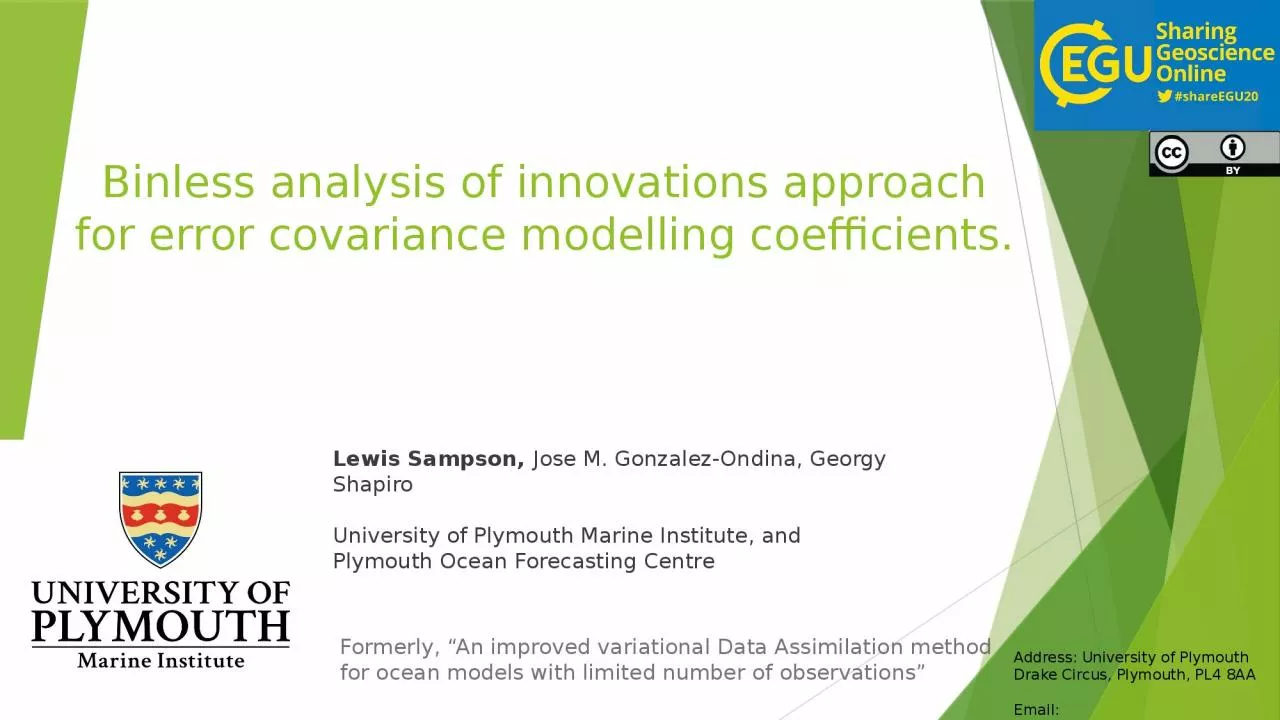

Formerly An improved variational Data Assimilation method for ocean models with limited number of observations Lewis Sampson Jose M GonzalezOndina Georgy Shapiro University of Plymouth Marine Institute and ID: 1045052
Download Presentation The PPT/PDF document "Binless analysis of innovations approac..." is the property of its rightful owner. Permission is granted to download and print the materials on this web site for personal, non-commercial use only, and to display it on your personal computer provided you do not modify the materials and that you retain all copyright notices contained in the materials. By downloading content from our website, you accept the terms of this agreement.
1. Binless analysis of innovations approach for error covariance modelling coefficients.Formerly, “An improved variational Data Assimilation method for ocean models with limited number of observations”Lewis Sampson, Jose M. Gonzalez-Ondina, Georgy ShapiroUniversity of Plymouth Marine Institute, andPlymouth Ocean Forecasting CentreAddress: University of Plymouth Drake Circus, Plymouth, PL4 8AA Email: lewis.sampson@Plymouth.ac.uk
2. Background error estimation for assimilation.In order to produce the background error covariance matrix of variational data assimilation, a covariance modelling process is used. This modelling requires the input of background error standard deviation and length-scale ratio. For operational suites, the Hollingsworth-Lonnberg (H-L) method is used to estimate the required error coefficients. The H-L method is an analysis of innovations approach, in which the innovations are used in combination with a spatial binning and curve fitting scheme to determine background error. The H-L method is not without weaknesses, it is reliant on spatially binning the innovations, and has the requirements for defining the curve fitting scheme and bin size. We have produced an alternate approach, which is the Binless Analysis of Innovations (BAI) method. Instead of using the bins to calculate innovation covariance, we use the law of large numbers to estimate a norm which can be used to infer background error. We find the optimum solution by minimizing this norm, of differences between the innovation product, , and a covariance model, .From this equation we form a system of equations with inner products, which we can solve for the background error. This process has the same computational costs as the H-L methods, but without the need for spatial bins or a curve fitting scheme. Background error for temperature, produced using the binless analysis of innovation method for error estimation. Used with the AS20 ocean nemo model and NEMOVar assimilation. Using satellite observations and model forecast for Winter 2014. Visual representation of the Hollingsworth and Lonnberg method of error estimation. The grey bars are the binned innovation covariances, the black curve is fit to this data ignoring the innovations at zero separation. The new value from this curve at zero separation is the background error variance.
3. Results of the binless analysis methodThe root mean square and mean of innovation error from assimilation runs using the error estimation from; the BAI method, the H-L method, and error values supplied to the Plymouth Ocean Forecasting Centre, from the Meteorological Office. The results are from a four week assimilation run for summer (left) and winter (right) 2014. The discordance of the BAI and H-L methods when operating with a subset of observations. The percent's used in the above plots are; 1, 10, 30, 50, 70, 90, and 100%. The figure on the left is for the standard deviations of the error estimation methods, and the left is for the short length-scale ratio.We have been able to apply both the H-L and BAI method to the AS20 NEMO model, using forecasts from a year long NEMOVar assimilation. In order to asses the ability of the methods we have shown the results of two independent experiments. The first is the RMSE and mean of innovation error from NEMOVar assimilation forecasts, and the second is a discordance relationship for the use with subsets of innovations.The NEMOVar assessment also uses the original standard deviation supplied to us from the Met Office, this ensures our attempts of independently applying the methods are sufficiently accurate. We can see that error changes in time, and that on certain days each method performs better or worse, but in general it seems that the BAI method is able to produce error estimates at a similar accuracy.The discordance plot is produced as a measure of how the methods deteriorate when using smaller subsets. We calculate the value of discordance using the result from the full set of observations for each method, as the truth or optimum solution. This results suggests a similar conclusion as the first, that our method is able to compete with operational methods.As we have removed some of the negatives from the H-L theory, we consider the BAI method a more statistically robust approach. Despite there being no improvements in the results, we are able to create a comparable estimate of background error without the need for spatial binning of innovations, or any type of curve fitting. Since we do not curve fit, we can easily apply the BAI method to any form of covariance modelling, including multi-dimensional and anisotropic options.
4. Additional results and ConclusionOur alternate approach is a simpler methods, where we do not use bins or a curve fitting scheme, but are still able to return the background error statistics. We still use the the innovation error, and the same assumptions on background and observational error that the H-L method uses. The BAI method is able to produce the background error standard deviation and length-scale ratio as required for NEMOVar, with comparable accuracy to the current methods.A large benefits of using the BAI is that the covariance model is fully flexible. We are able to apply the error estimation to any form of covariance modelling, including two dimensional and anisotropic. Feel free to ask me any questions in the live chat.